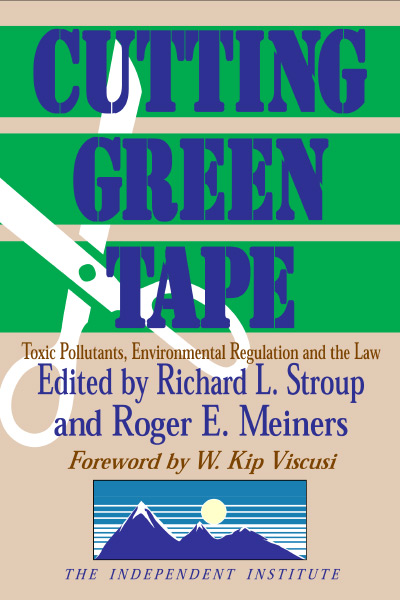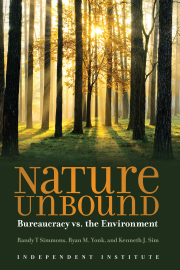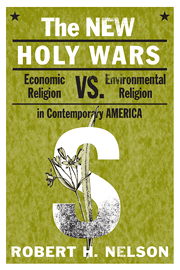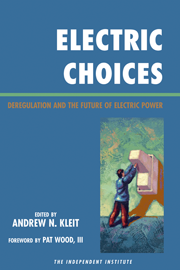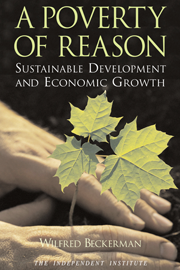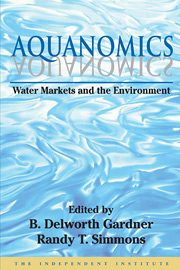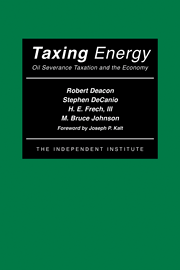| List Price: | ||
| Price: | $20.25 | |
| Discount: | $6.70 (Save 25%) |
| List Price: | ||
| Price: | $20.25 | |
| Discount: | $6.70 (Save 25%) |
Overview
Cutting Green Tape examines whether the lack of prioritization and selectivity is inherent in current regulation and whether such policies have cost the economy untold millions, diverted attention away from real health and safety risks, and created disincentives against safeguarding against actual hazards.
With sobering assessment of the difficulties of risk analysis and the dangers of “deep-pocket” liability, as opposed to that for responsible parties, this unique and powerful book questions the cumbersome and contradictory regulation by the environmental bureaucracy, including such topics as air toxics, groundwater, risk assessment and insurance, toxic torts by government, and much more.
Cutting Green Tape resolves many of the most difficult environmental health and safety problems through innovative, practical, and economically and ecologically sound market-based and common-law alternatives to government bureaucratic failure.
Contents
- Introduction: The Magnitude of the Toxic Liability Problem
- Richard L. Stroup, Roger E. Meiners
- Chapter 1: Superfund and Risky Risk Reduction
- Bruce Yandle, Professor of Legal Studies, Clemson University
- Chapter 2: Air Toxics: Liability from Thin Air
- Richard L. Stroup
- Chapter 3: Toxic Torts by Government
- Bruce L. Benson, Professor of Economics, Florida State University
- Chapter 4: Common Law Theories Applicable to Environmental Pollution/Toxic Tort Legislation
- Jo-Christy Brown, Attorney, Brown, McCarroll & Oaks and Rogers E. Meiners, Professor of Economics, University of Texas, Arlington
- Chapter 5: Toxic Torts: Problems of Damages and Issues of Liability
- David D. Haddock and Daniel D. Polsby
- Chapter 6: Insurance, Information and Toxic Risk
- Donald N. Dewees
- Chapter 7: Contracting for Health and Safety
- Daniel K. Benjamin
- Chapter 8: Regulation of Carcinogens: Are Animal Texts a Sound Foundation?
- Aaron Wildavsky
- Chapter 9: Protecting Groundwater and the Unintended Transport of Toxic Substances by Water
- David T. Fractor
- Chapter 10: Assessing Social and Legal Consequences of Scientific Ambiguity
- Kenneth R. Foster, David E. Bernstein, Peter W. Huber
- Appendix
Detailed Summary
- Who gets away with being the nation’s top polluter and helps others remain above the law? The federal government serves as the “largest single source of demand” for toxic substances, and immunizes itself—and government contractors—from liability.
- Who decides what happens in your backyard? There is little reason to believe that the “experts” can assess risk better than individuals acting alone or through markets.
- Government agencies are culpable for Love Canal: The EPA trumpeted the fears from Love Canal to garner support for its own bureaucratic expansion through passage of Superfund, which could cost the nation $1 trillion, with no measurable reductions in toxic hazards. And, any culpability for Love Canal rests squarely with government agencies that confiscated the land and refused to comply with environmentally-sound practices.
- The worst asbestos offender: In the face of numerous personal injury lawsuits, 16 asbestos companies have declared bankruptcy. But, “the most proximate cause of the most severe asbestos-related health problems was the U. S. Government,” which remains unaccountable.
- Can one be “too careful”? The likely health benefits from EPA regulations setting exposure limits some 374,000 times less than a dose shown to cause harm in animals range from insignificant to nonexistent.
- Environmental quality: Clean air, water, and land are best produced by competitive markets with well- specified, tradeable, and accountable property rights.
The comprehensive new book, CUTTING GREEN TAPE, critically examines the problems of environmental hazards and quality, and the impact of government regulations and litigation. As Kip Viscusi of Harvard Law School explains in his foreword, and as economist Bruce Yandle of Clemson University also discusses, the Superfund program is fundamentally flawed. The Superfund program:
- Directs massive sums of money to remedy supposed environmental hazards that fail to meet the most basic standards of scientific evidence.
- Focuses inordinate attention on insignificant risks while diverting resources from truly substantial hazards.
- Initiates hazardous waste cleanup efforts that might prevent one case of cancer—but at a cost of $10 billion.
- Could save many more lives if it focused resources on lower-profile endeavors, like improving highway safety.
Superfund is not the only government program that exploits an apparent crisis to generate benefits for political and bureaucratic special interests. While such programs may sound noble, if taken seriously they would bankrupt the nation with little or no environmental value produced.
Protecting Air, Water and LandIn CUTTING GREEN TAPE, Montana State University economist Richard Stroup analyzes the Clean Air Act and related air toxics legislation, finding that:
- The Clean Air Act requires a reduction in the lifetime risk of death due to air toxics emissions to less than one-quarter the unlikely risk of being struck by a falling airplane.
- Complying with Superfund alone could cost the nation more than one trillion dollars.
Economist David Fractor examines the role and importance of groundwater, how and when groundwater may be threatened, and what can be done to protect or to rehabilitate this resource. Fractor notes that when property rights in groundwater quality are fully specified and protected, damages and damage risks can be properly managed to minimize the sum of all costs. Setting up such a system is costly and complex, but Fractor believes that new technologies and better science are reducing the costs so that the benefits of the information and incentives produced by a system of property rights and market trades will become attainable.
University of Texas economist Roger Meiners and attorney Jo-Christy Brown survey the legal history and operation of the common law rules of nuisance, trespass, and strict liability for abnormally dangerous products as they have operated in the United States. Under the common law, liability follows a demonstration of harm. Superfund and other environmental statutes routinely fail to make that logical linkage because Congress did not base the statutes on risks and benefits or scientific evidence of existing or likely harm.
The relationship between environmental issues and the common law is explored by law professors Donald Dewees, David Haddock and Daniel Polsby. Dewees examines the law and economics of the various common law rules. Haddock and Polsby simulate the operations of the different common law rules and arrive at some novel conclusions. Strict liability is unlikely to function well as an insurance system and when plaintiff actions are important causes of accidents and difficult to observe, negligence rules have superior deterrence properties to any variant of strict liability. It follows that negligence rules, which have become less common in the U.S. legal system over the past several decades, may often be superior to rules emphasizing strict liability.
In “Rent Seeking on the Legal Frontier,” Florida State University economist and Independent Institute Senior Fellow Bruce Benson outlines the sharp changes in tort law which have occurred over the past three decades. Legal instability has created enormous social costs. When property rights to revenues become insecure, trial lawyers and others pursue these insecure rights by filing lawsuits. The resulting litigation has overwhelmed the courts, causing delays, high costs, and numerous injustices.
Bureaucracy’s Polluted and Wasteful LegacyIn a separate chapter on federal and state impacts on the environment, research by Professor Benson reveals:
- Government agencies may be the largest single source of demand for potentially toxic substances. They use large quantities of allegedly toxic products in ways that put people at risk, often without warning the people or owners of property at risk or even acknowledging the risk.
- Despite evidence of substantial knowledge by government officials of potential health hazards of Agent Orange, the government denied virtually all liability.
- The Department of Defense knew of potential risks associated with experimental drugs and vaccines before the Gulf War, but administered them to troops anyway, with no warning of side effects and no monitoring afterwards.
- The vast majority of asbestos victims worked in government shipyards, but the U.S. Government continues to reject any moral or legal obligations to the victims.
Legal policy expert Peter Huber, University of Pennsylvania bioengineering professor Kenneth Foster, and George Mason University law professor David Bernstein discuss scientific testimony in the courtroom and how it can be made more reliable and reflective of real science. The authors point out that although the number of eyewitnesses to an accident may be limited, a lawyer can almost always find an “expert with a pleasing courtroom manner who will testify in support of the attorney’s theory of the case.” As a result, the courtrooms are often filled with frivolous theories rejected by mainstream science. Letting the jury “hear the evidence” and sort out the truth is equivalent to arguing that a jury is capable of evaluating rival scientific theories, a job difficult enough for scientists!
At the federal level, the Daubert and Joiner decisions required judges to rule unscientific evidence inadmissible and provided guidelines to determine what is unscientific. Unfortunately, most state courts have not yet adopted Daubert, much less Joiner, leaving plenty of opportunities for the admission of scientifically invalid testimony into legal proceedings. Within a few months after Joiner was decided, state courts in Massachusetts and in Oregon admitted highly questionable evidence that breast implants cause disease. The authors encourage state courts to adopt clear standards for scientific evidence, similar to those in Daubert and Joiner. They further suggest that judges appoint expert witnesses to advise them on scientific matters beyond their knowledge, a practice becoming more common in many courts.
Although many people have claimed that individuals do not estimate risk well and typically conclude that government regulation is therefore warranted, Clemson University economist Daniel Benjamin disputes both parts of such claims. Previous studies on risk assessment have asked individuals to estimate the probability someone in the U. S. is killed by X (e.g., lung cancer, heart disease, airplane crash, etc.) Surprisingly, they have not been asked the more relevant question: “What is the probability that you will be killed by X.” After reevaluating the evidence, Benjamin finds that:
- When asked about risks pertinent to them, individuals are much better at assessing risks than previously thought.
- When the rewards of being right are high, people become better at assessing risk.?
The late Aaron Wildawsky’s contribution to CUTTING GREEN TAPE questions the use of animal tests as a scientific foundation for government regulation of carcinogens:
- Scientists are not agreed on the correct statistical model to evaluate data from animal experiments. Statistical models that depend on different assumptions predict harms that vary by a factor of 200 for DDT, 800 for dioxin, and 40,000 for aflatoxin, a naturally occurring toxic substance found in various foods such as peanut butter.
- Without a plausible biological reason for preferring one model over another, the results of these tests are no better than guesswork.
CUTTING GREEN TAPE provides the essential framework to understand and resolve many of the most difficult environmental health and safety problems through innovative, practical, and ecologically sound common law and market-based alternatives to bureaucratic failure.
Praise
“Cutting Green Tape is an excellent in-depth book on the cost and ineffectiveness of toxic liability law and the need for reform based on principles of responsible economic risk management.”
—Vernon L. Smith, Nobel Laureate in Economic Sciences, Chapman University
“What an excellent job! Cutting Green Tape is required reading for students, professors and policy-makers in environmental studies. It is the new standard for the field.”
—Michael I. Krauss, Professor of Law, George Mason University
“Environmental policy is easy to support in the abstract, but hard to implement in the concrete. Producing policies that yield net social benefits requires a willingness to respond to major risks when they occur, which can be done effectively only by those who have the courage to reduce the resources devoted to counteracting lesser risks. The distinguished set of authors in Cutting Green Tape have all mastered this fundamental lesson about environmental policy. They vigorously attack the excesses of current government policies. They do not pretend, however, that it is possible to dispense with direct public engagement with environmental issues. But they do offer proposals to make the enforcement of environmental policy more effective and less intrusive-a rare double that can be achieved given the confused state of so much of our current environmental policy.”
—Richard A. Epstein, James Parker Hall Distinguished Service Professor of Law, University of Chicago
“Billions of dollars have been spent on hazardous waste cleanup in the United States and multi-million dollar lawsuits proliferate; yet progress in reducing actual toxic threats to human health and the environment is dubious. Cutting Green Tape illuminates the consequences of a cumbersome and often contradictory bureaucratic regime of environmental regulation and the dangers of a ‘deep pocket’ liability system. This informative edited collection contains eleven chapters covering Superfund, the regulation of airborne toxins, toxic torts and damage awards in civil suits, and the difficulties of risk analysis, in terms of both risk assessment and risk management. W. Kip Viscusi provides an excellent foreword, followed by contributions from an of scholars array including lawyers, consulting economists, and professors of law, economics, bioengineering, and public policy. . . . This book highlights the inefficiency of our current regulatory regime in addressing risks of toxins through analysis of both market failure and institutional failure. Prominent are the analyses of the lack of incentive for efficient risk management by government and the inefficiency of the tort system. . . . Cutting Green Tape illuminates the complexities of both liability law and regulatory risk management. Though weak on solutions, this book makes clear the need for reforms in the regulation of toxins based on efficient risk management. Anyone with an interest in environmental regulation and risk analysis should read this book. This book would also provide an exciting, interdisciplinary foundation for any course in environmental regulation covering economic, legal, and epidemiological issues.”
—American Journal of Agricultural Economics
“Whatever one may think of environmental regulation, it is clear that policies should be designed to achieve as much ‘cleanliness’ as is possible for a given level of spending. Cutting Green Tape shows that current policies do not do this: they waste massive amounts of money and often produce even greater problems. This excellent book formulates policies that would end this waste while doing the needed job to produce a cleaner environment. The authors are among the leading environmental scholars in the U.S., and anyone with an interest in the environment or in efficiency should read and refer to this important and comprehensive book.”
—Paul H. Rubin, Professor of Economics, Emory University
“During my own days of studying economics, I remember how effluent limits were the regulatory norm and how textbook stories about possibly trading pollution rights were met with chuckles or snickers. Yet here we are today trading rights to sulfur dioxide and nitrogen oxide emissions. Cutting Green Tape would seem to be the ideal textbook applied to today. Professors Stroup and Meiners have assembled an interesting book that presents a convincing case for the massive inefficiencies in current regulatory schemes. Considering the benefits and costs, this volume shows how many current programs are either knowingly wasteful, or basing their ‘value added’ on weak evidence. Although I find myself disagreeing with some of the conclusions in the book, I must admit that the evidence presented does cause me to reevaluate my own opinions. Certainly Cutting Green Tape will be an important reference in the ongoing debate as to how do we best handle environmental risks and toxic exposures.”
—Harris Schlesinger, Professor of Finance, University of Alabama
“Cutting Green Tape’s stellar benefit is the conclusion in the late Aaron Wildavsky’s chapter that asserts, ‘It is not the cost, however, that is the strongest argument against the criteria used to regulate chemical exposures in the United States today; the strongest argument is that there are no health benefits.’ Thirteen economists and lawyers, one engineer, and one political scientist have contributed to Cutting Green Tape. The result is an excellent text for law and economics courses. Additionally, policymakers will derive exceptional insights from contributor Bruce Benson’s efforts, unmasking the problems of government causation and immunity. Cutting Green Tape addresses what is needed in toxic torts, environmental regulation and the law to usher in updated policies that deliver health benefits. The possibility unleashed by improved policies is a rich theme found throughout this welcome book.”
—Floy Lilley, Clint W. Murchison Senior Chair, College of Engineering, University of Texas
Author
Richard L. Stroup is Professor of Economics at Montana State University and a Research Fellow at The Independent Institute
Roger E. Meiners is Professor of Economics at the University of Texas, Arlington, and a Research Fellow at The Independent Institute

